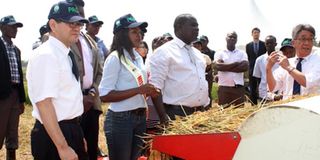Uganda set to hit rice production target

Dr Kazuhiko Yagi, the chief advisor, PRiDe project (right), explains how the simple rice threshing machine works to NaCRRI director Dr Godfrey Asea (centre), Miss Uganda Zahara Nakiyaga and Yutaka Nakamura, the deputy head of mission, Japanese Embassy. PHOTO BY CHRISTINE KATENDE
Mechanising agriculture will encourage the youth to get involved in agriculture, a move which will help Uganda to fight unemployment and overcome poverty.
This was in the remarks by Kyosuke Kawazumi, the chief representative, Japan International Cooperation Agency (Jica), while officiating at a demonstration of agro-machinery manufactured in Uganda, at National Crops Resources Research Institute (NaCRRI) in Namulonge, Wakiso District.
The demonstration done in partnership with Miss Uganda Foundation is part of efforts to boost national rice production targets—from 106,700 tonnes in 2008 to 443,800 tonnes in 2018.
Although certain parts like engines are imported, the machines are made in Uganda with technical assistance by experts from Japan through support from Promotion of Rice Development (PRiDe) project.
Self-sufficiency
The agro-machinery include a de-stoner (which removes stones from rice) and a thresher (which separates the rice grains after harvest) and a manual water pump (which is operated by pedals to pump water for either irrigation or other farm purposes).
Dr. Godfrey Asea, the director, NaCRRI, noted that agricultural mechanisation is one of the biggest hindrances in transforming Uganda’s agriculture from subsistence to commercial agriculture.
“We are on track to achieve our targets. We have already achieved self-sufficiency. National production stands at 300,600 tonnes,” he said. “The country has reduced imports considerably and we have begun exporting to D. R. Congo and South Sudan.”
Dr Kazuhiko Yagi, the chief advisor, PRiDe project, said farmers need to adopt good farming methods in order to improve the quality of rice produced.
“Rice farmers in Uganda are still using rudimentary tools in production and end up with poor quality because for example to thresh, they beat the rice with sticks which breaks the rice grains. This innovation will make it easier for farmers or farmer groups to purchase machines like threshers. Broken rice cannot compete favorably in the regional market,” Dr. Yagi said.




